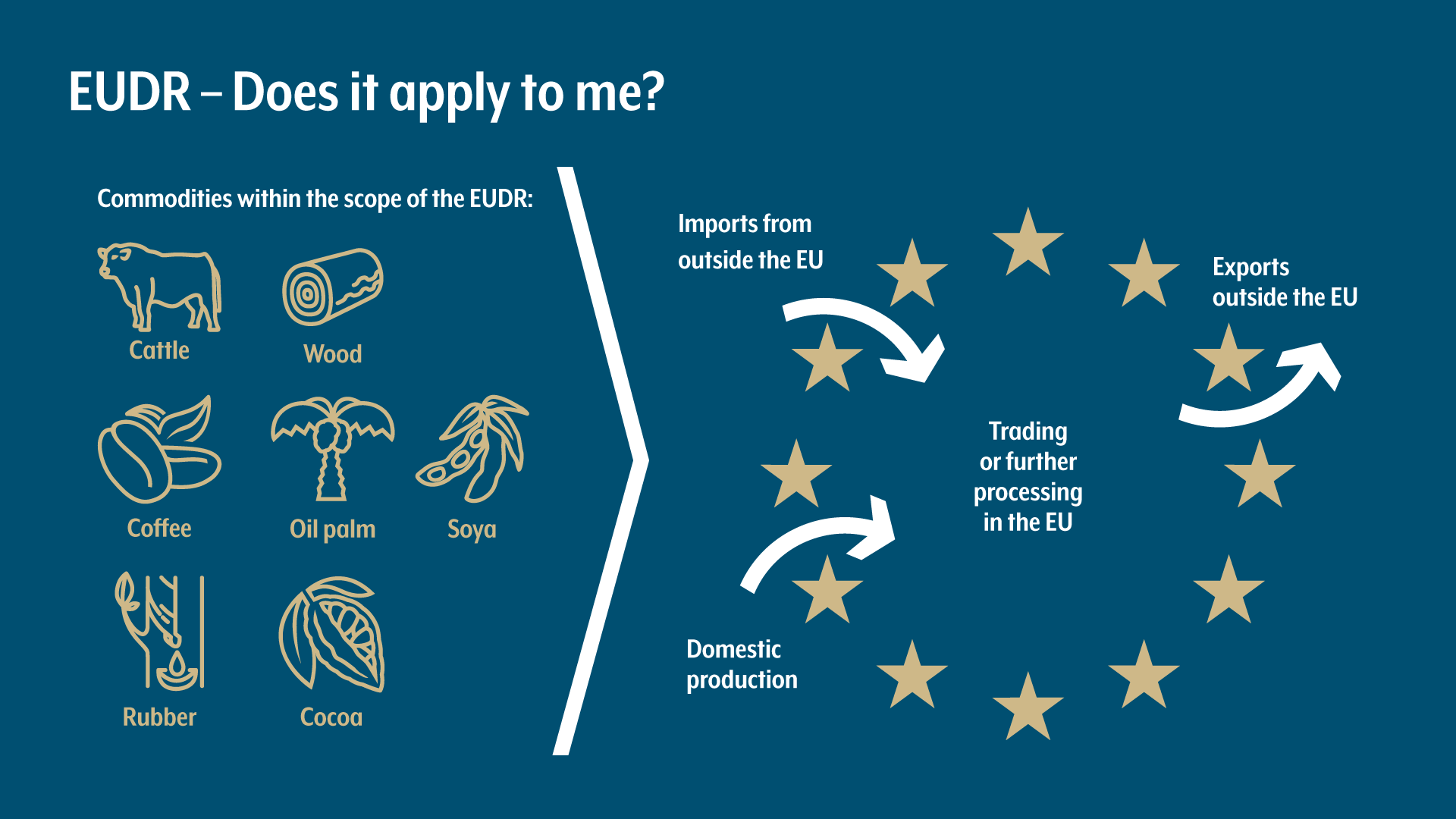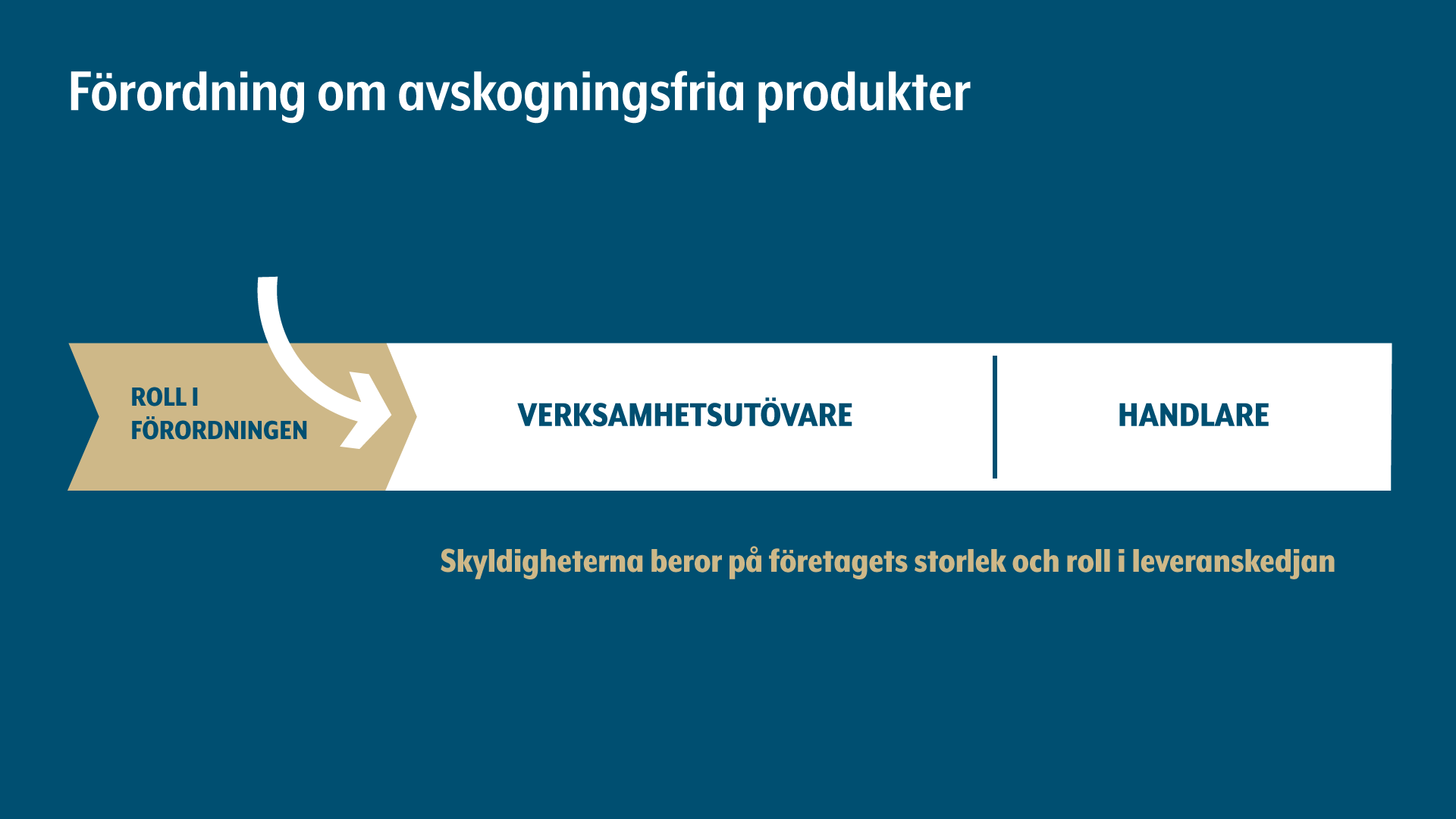The EUDR will enter into force at the end of 2025. It applies extensively to companies in various sectors in different parts of production chains. On this page, you can find a summary of the EUDR’s key points. Read more on other pages on this website or in the EUDR text.

Does the EUDR apply to you?
The EUDR covers wood, meat and other parts of cattle, coffee, cocoa, soya, oil palm and rubber, as well as the products made from them that are listed in Annex 1 to the EUDR.
The EUDR applies to imports into the EU, exports from the EU, domestic and intra-EU trade, domestic production, as well as domestic and intra-EU further processing.
It defines certain expectations for the aforementioned operators and traders. The measures required depend, for example, on the company’s size and its role in the supply chain.
It will enter into force on 30 December 2025. For micro- and small-sized enterprises, the transitional period will continue until 29 June 2026. Note: The extended transitional period does not apply to products subject to the current EU Timber Regulation (EUTR).
What is the EUDR all about?
The EUDR will improve the traceability and transparency of wood, rubber, cattle, coffee, cocoa, oil palm and soya, as well as the products made from them that are listed in Annex 1 to the EUDR.
The purpose of the EUDR is to reduce global deforestation, forest degradation and biodiversity loss.
As a result of the EUDR, the commodities and products listed in Annex 1 to the EUDR can only be placed on the market when
- they have not caused deforestation;
- they have been produced in accordance with the legislation of the country of production; and
- they are covered by a DD-statement.
Identify your role under the EUDR
The measures required by the EUDR vary depending on whether your company’s role is regarded as an operator or trader in accordance with the EUDR.

Roles defined in the EUDR with examples
OPERATOR
The following are regarded as operators, regardless of the size of the company:
- Companies importing from outside the EU
- Companies exporting outside the EU
- Cattle slaughterhouses and farms engaged in direct sales
- Wood buyers in standing sales, forest owners in harvesting for forest owners’ private use and in delivery sales
For the following, the role under the EUDR depends on the size of the company:
- Large undertakings engaged in trade are operators (check the size categories here, Article 3)
- Further processors that make any of the end products listed in Annex 1 are either operators or small- or medium-sized operators.
TRADER
- Micro-, small- and medium sized enterprises and natural persons that place products available on the market domestically or in the EU.
NOTE: Large undertakings engaged in trade are regarded as operators in the EUDR.
Examples
Importers of wooden furniture are operators, regardless of the size of the import company.
If, as a small- or medium-sized company, you buy wooden furniture from an importer and sell them in your shop, your role is a trader.
What measures does the EUDR require?
The EUDR requires slightly different measures from companies in various roles. A summary of the measures required from each role is presented below. In addition to the role defined in the EUDR, the size of the company determines what measures are required. For more detailed information about the obligations, read Chapter 2 of the EUDR.
Measures by role
Before placing products on the market, ensure the following measures.
Operator
- Verify whether the EUDR applies to you
Identify whether your product is listed in Annex 1. The listed commodities and products are within the scope of the EUDR’s obligations. - Make sure that your DD system is appropriate
Your company must have an appropriate due diligence (DD) system. You need to identify the origin and supply chain of your products and verify that your products do not cause deforestation. The system consists of three elements: information procurement, risk assessment, and risk mitigation. The DD system is required for the DD statement. - Complete your DD-statement in the TRACES system
Complete your DD-statement well before imports, exports or placement on the market. - Pass the reference number forward
Forward the DD-statement’s reference number assigned to the batch in question to the product buyer if it is a corporate customer. - Reporting obligation of large undertakings
Large undertakings are obligated to issue public reports on their DD-system on an annual basis.
Natural person, micro-, small- or medium-sized operator that is engaged in further processing
- Verify whether the EUDR applies to you
Identify whether your product is listed in Annex 1. The listed commodities and products are within the scope of the EUDR’s obligations. - Make sure that you obtain the DD-statement’s reference number
When a DD statement has already been issued for the commodities and products listed in Annex 1, make sure that you obtain the DD-statement’s reference number assigned to the batch in question from the party preceding you in the supply chain.
Forward the DD-statement’s reference number assigned to the batch in question to the product buyer if it is a corporate customer.
Natural person, micro-, small- or medium-sized enterprise engaged in trade
- Verify whether the EUDR applies to you
Identify whether the traded product is listed in Annex 1. The listed commodities and products are within the scope of the EUDR’s obligations. - Collect and retain information about the suppliers of the products in question
Identify the company’s name, registered trade name or trademark, address, email and URL. - DD statement’s reference number
Make sure that you obtain the DD-statement’s reference number. - Pass the DD-statement’s reference number forward
Forward the DD-statement’s reference number assigned to the batch in question in the case of a corporate customer.
Why should my company take care of the EUDR’s measures before the end of 2025?
The EUDR will enter into force on 30 December 2025, after which it must be ensured, with regard to commodities and products falling within the scope of the EUDR, that the requirements set out in the EUDR are met in exports, trading and placement on the market.
Once you have ensured the measures required by the EUDR for imports or exports and have issued a DD-statement, the customs declaration process will go smoothly, and the relevant batch will not be stopped on the border or even returned to its point of departure.
The collection of information, risk assessment and risk mitigation required by the EUDR for commodities and products improve companies’ responsibility, as well as their understanding and transparency of their supply chain. This reduces the risk of unexpected reputation loss regarding commodities and products.
Consumers can more reliably purchase the products falling within the scope of the EUDR because law requires that their production chain has not caused global deforestation or been in breach of the legislation of the country of origin.